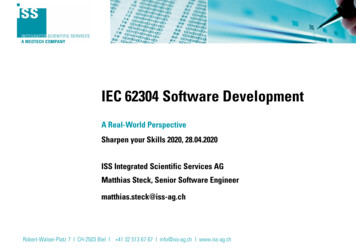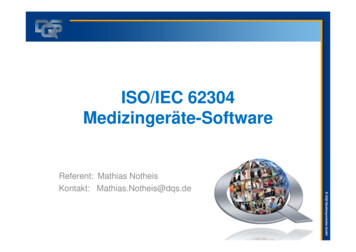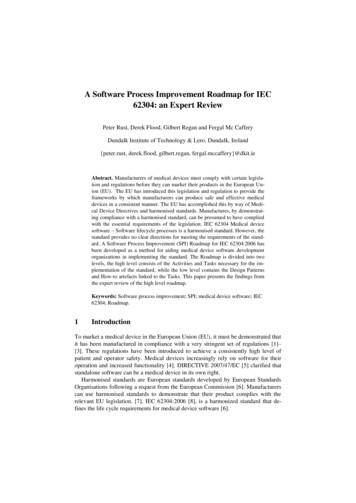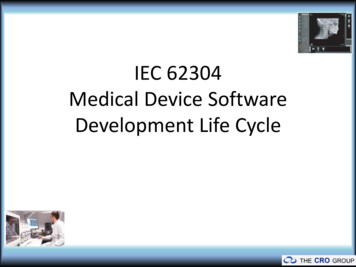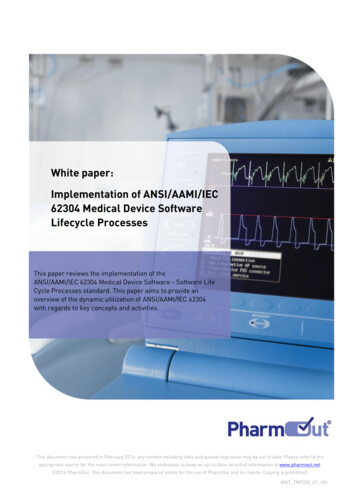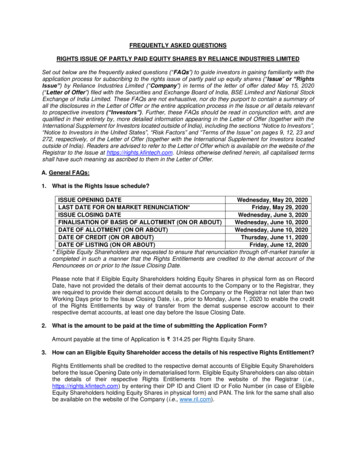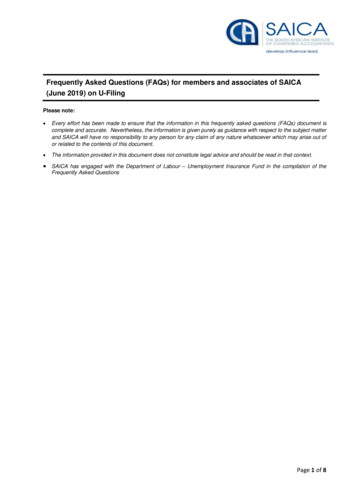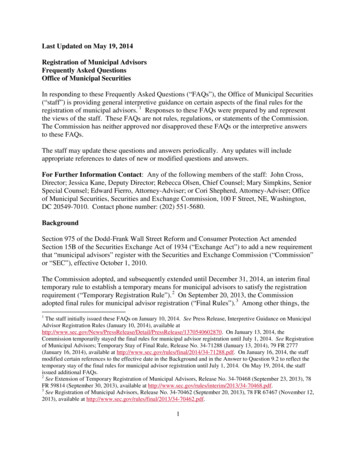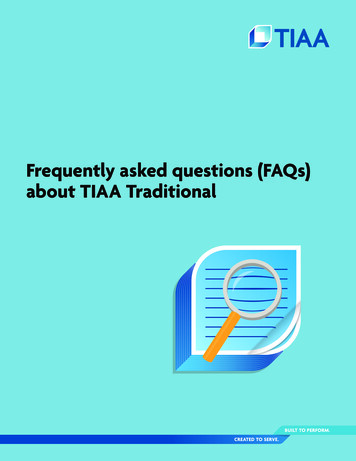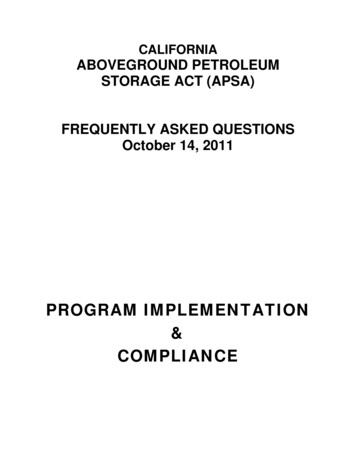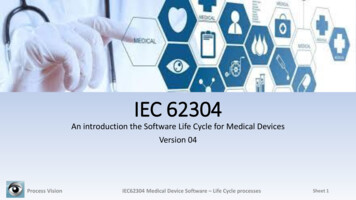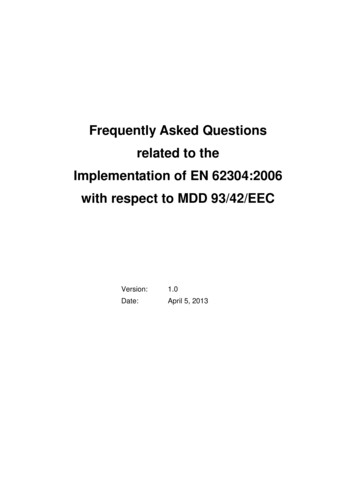
Transcription
Frequently Asked Questionsrelated to theImplementation of EN 62304:2006with respect to MDD 93/42/EECVersion:1.0Date:April 5, 2013
EN 62304:2006 - Frequently Asked Questions empty page Page 2
EN 62304:2006 - Frequently Asked QuestionsTable of ContentsIntroduction .51Abbreviations .72Questions and Answers .92.1 Scope of EN 62304 .92.2 Placing Software as MEDICAL DEVICE on the Market .132.3 Life-cycle Processes .152.4 Risk Assessment and Risk Management .192.5 Classification and Segregation .212.6 Specifications, testing and tools .272.7 SOUP and Legacy Software.30References .33Annex 1Software Problem Resolution Process .35Annex 2SOUP selection, assessment & qualification .37Annex 3Traceability .39Annex 4Position paper on direct diagnosis (COCIR, 2011).41Acknowledgement .43Page 3
EN 62304:2006 - Frequently Asked Questions empty page Page 4
EN 62304:2006 - Frequently Asked QuestionsIntroductionAim of the FAQ 62304The international standard IEC 62304 (“MEDICAL DEVICE software– Software life-cycle processes”) provides requirements for thedevelopment and maintenance of medical software. Published in2006, it covers software, both embedded in MEDICAL DEVICEs andas a MEDICAL DEVICE. In Europe, the -technically identicalEN 62304 version is a harmonized standard under all threeMEDICAL DEVICEs directives:AIMDD, 90/385/EEC; MDD, 93/42/EEC; and IVDD, 98/79/EC.This document aims to clarify questions that relate to the use ofEN 62304:2006 in the context of the European MEDICAL DEVICEsDirectives. It also intends to provide guidance on technical andregulatory matters relevant for application of the standard. Finally,this document also aims to be a reference for medical softwaremanufacturers, as well as for Notified Bodies dealing with medicalsoftware. Although this document has been reviewed by avoluntary team consisting of a few NBs, the aim is that it should beused by all NBs as a reference document to ensure moreconsistent application of the standard.RationaleIn recent years, many questions have arisen concerning how certain elements of the standard needto be understood in the context of the European MEDICAL DEVICE regulatory framework. Experts fromEuropean Notified Bodies and European MEDICAL DEVICE industry started to request and collectthese questions.Questions submitted, numbering well over one-hundred, have been sorted and categorized. Somequestions showed overlap, others could be combined. Eventually, 73 unique questions remaineddivided into seven categories. Answers were prepared by the drafting team, and reviewed by theIEC/ISO group which developed IEC 62304 and some European Notified Bodies.Drafting teamThe drafting team consisted of the following people:Jomuna Choudhuri, VDE Test and Certification InstituteKoen Cobbaert, Quality, Regulatory and Risk Management, Agfa HealthcareGeorg Heidenreich, Quality & Technology, Siemens AG - Healthcare SectorFrans Jacobs, Regulatory Affairs manager X-ray products, Philips HealthcareGerd Neumann, Software Standardization Expert, Siemens AG - Healthcare SectorMichael Bothe, Head of Medical devices/Processes/Systems, VDE Test & Certification InstitutePeter Linders, Chair Technical & Regulatory Affairs Committee, COCIRComments on this FAQ may be submitted to: FAQ62304@vde.com. We realize that this FAQ isneither perfect nor complete. Depending on the comments we receive on this FAQ, or on otherdevelopments related to implementation of IEC 62304 in Europe, we may decide to update oramend this publication.Page 5
EN 62304:2006 - Frequently Asked Questions empty page Page 6
EN 62304:2006 - Frequently Asked Questions1AbbreviationsWords written in SMALL CAPS are defined terms. Their definition can be found in the “Termsand Definitions” section of IEC 62304AIMDD . Active Implantable MEDICAL DEVICE DirectiveCMS . Configuration Management SystemCOCIR . European Coordination Committee of the Radiological,Electromedical and Healthcare IT IndustryCOTS . Commercial off-the-shelfEEC . European Economic CommunityEUROM VI . European Federation of Precision Mechanical and OpticalIndustries – Medical TechnologyFPGA . Field Programmable Gate ArrayGPO . General Practitioner’s OfficeIEC. International Electrotechnical CommissionISO . International Organization for StandardizationIVDD . In-Vitro Diagnostic DirectiveMDD . MEDICAL DEVICE DirectiveMEDDEV . Non-binding guidance for MEDICAL DEVICES, endorsed by EUMember ocumentsMPBetreibV . Medizinprodukte – BetreiberverordnungVerordnung über das Errichten, Betreiben und Anwenden vonMedizinprodukten(Medical Devices Operator OrdinanceThe regulations governing the setting up, operation, use andmaintenance of medical devices)Relevant only for GermanyNB, NBs . Notified Body, Notified BodiesPEMSProgrammable Electrical Medical SystemSAAS . Software as a serviceSDD . Software Detailed Design,SIL . Safety Integrity Levels as per IEC 61508SOUP. Software of Unknown ProvenanceTÜV . Technischer Überwachungsverein(Technical Inspection Association)VDE . Verband der Elektrotechnik, Elektronik undInformationstechnologien(Association for Electrical, Electronic and InformationTechnologies)Page 7
EN 62304:2006 - Frequently Asked Questions empty page Page 8
EN 62304:2006 - Frequently Asked Questions2Questions and Answers2.1Scope of EN 623042.1.1Does EN 62304 relate to only the MDD (93/42/EEC)?Answer:No, the standard has been harmonized under all three medical devices directives but forsimplicity only the MDD is mentioned in this document.2.1.2When is software considered a MEDICAL DEVICE?Answer:See MEDDEV 2.1/6 (chapter 2).2.1.3How does the standard distinguish between open and closed systems?Answer:There is no differentiation in the standard between closed or open systems.2.1.4Assuming all software has a medical purpose, does the standard apply to thefollowing?a)SAASb)Embedded software including FPGA's with single chip computersc)Hardware Description Languages specifying FPGAsd)Stand alonee)Medical appsf)Excel macrosg)Open and closed systemsh)Internet or cloud basedi)Server based systemsj)Network devicesAnswer:If the intended use qualifies the software as a MEDICAL DEVICE or if the software is part of aMEDICAL DEVICE, all of the above are within the scope of the standard, as long as suchsoftware can be executed during the intended operation. Notes:a) SAASIn some case, the service provided is not only the use of the software but can also includevarious additional services for instance:- Data storage capability- Medical expertise/decision- MDD does not cover the overall service provided.MDD only covers design, manufacturing and regulatory post market activities of the medicaldevices.Nevertheless, it is the responsibility of the MD legal manufacturer of the software intendedto be used as part of a wider service to manage the specific risks related to the use of thesoftware itself under the service environment.Page 9
EN 62304:2006 - Frequently Asked Questionsb) Embedded software including FPGA's with single chip computersSoftware executed on a processor (can also be part of a FPGA) during the intendedoperation is considered a software item under EN 62304.c) Hardware Description Languages specifying FPGAsSpecifications (e.g. in some Hardware Description Language) to be executed duringproduction of the FPGA are considered tools and do not fall under the term medical deviceand are not SW items in the sense of IEC 62304.d) Stand aloneSince 2007 the MDD considers software not intended to be used specifically forincorporation into a physical medical device as an independent medical device in its ownright, provided its intended use includes medical purposes.e) Medical appsDespite its easy availability and easy installation, apps with an intended medical use fallunder the MDD and must be created according to EN 62304.f) Excel macrosExcel macros sold with an intended medical use fall under the MDD and must be createdaccording to EN 62304.However, if the clinician creates own macros or modifies existing ones this work is underthe MPBetreibV if used in Germany. In other Member States, other requirements mayapply.g) Open and closed systemsSee question 2.1.3h) Internet or cloud basedi) Server based systemsj) Network devicesAn internet based, server based or cloud based software that meets the definition of theMDD is a medical device. Any general purpose operating system or network software is aSOUP. Any general purpose commercially available hardware devices such as network orstorage capability that does not meet the definition of an accessory according MDD are onlynon-medical components. Nevertheless, risk associated with such HW architecture has tobe managed in the medical device risk management file.2.1.5Can a manufacturer get a process and a product certification based on EN 62304?Answer:Some notified bodies provide services relating to EN 62304 and even issue “private”certificates which do not fall under a specific accreditation yet. Therefore, such acertification is not mandatory.2.1.6What information is the EN 62304 providing in regard to the life-cycle management ofmedical devices incorporated into an IT medical network?Answer:It is not providing any information related to IT medical networks because EN 62304 appliesto software in a MEDICAL DEVICE or to software as a MEDICAL DEVICE in its own right.Page 10
EN 62304:2006 - Frequently Asked Questions2.1.7Does EN 62304 cover all requirements in the General Principles of SoftwareValidation (as published by FDA) for product software?Answer:EN 62304 does not cover software validation. It is intentionally left outside of the scope ofthe standard. As for embedded software, PEMS validation is a system level activity andthus is covered in chapter 14 of EN 60601-1 (3rd. Ed.). The future IEC 82304 will covervalidation of software-only products (standalone software). A less direct link to validation forthese products is triggered in EN-ISO 13485:2012 because this standard (although notmandatory under EN 62304 (see clause 4.1)), also sets requirements for design anddevelopment validation in clause 7.3.6.The FDA guidance uses the term “validation” to mean the sum total of verification activities which are covered by EN 62304 - and the subsequent validation that the verified softwaresatisfies its user needs and intended use.2.1.8As validation and final release are not included in EN 62304, which standard providesthe requirements for these activities such that compliance with the MDD can beachieved / proven?Answer:For embedded software, validation is covered in chapter 14 of EN 60601-1 (3rd. ed.) withinthe context of the entire system. For standalone medical software, no current standardcovers the validation aspects of the essential requirements of the Directive.However, manufacturers of stand-alone software who apply quality management standardssuch as EN ISO 13485 have to fulfill the validation requirements of that standard.2.1.9What are the expectations of the Notified Bodies in regard to EN 62304 Compliance?Answer:Compliance with EN 62304 gives the presumption of conformity with some of the essentialrequirements of the Directive. If the standard is not applied, the manufacturer has to provideother objective evidence showing the software is in conformance with the correspondingessential requirements. Although the application of the standard is voluntary, it representsthe current state of the art and as such shall be used by the Notified Body as a frame ofreference for assessing the objective evidence supplied by the manufacturer.2.1.10 Is tailoring of the standard allowed when only some degree of compliance can beclaimed?Answer:The software as a product must comply with the applicable essential requirements of thedirective. EN 62304 can be used to support the claim of compliance with the applicabledirective.Tailoring is not allowed from the perspective of "degree of compliance"; however,depending on the safety classification of the software, the standard adapts the requirementsregarding the extent of content and documentation needed (less for class A software).Nevertheless, if compliance to EN 62304 is claimed, full compliance needs to be achievedfor all applicable clauses.2.1.11 Will my organization need a full re-assessment once a new version of the standard ispublished?Answer:It depends on the changes in the second edition of IEC 62304 and (with regard to therequirements of the MDD) on whether the second edition is harmonized, superseding thefirst one.Page 11
EN 62304:2006 - Frequently Asked Questions2.1.12 Class A Software.While I recommend using EN 62304 also for a "true" Class A software, don't you thinkthat the status of Harmonized standard with regulatory impact for Class A is aconstraint because by definition "No injury or damage to health is possible"?Answer:No, it represents the minimal set of activities and tasks which should be performed whendeveloping and/or maintaining medical software to demonstrate that it is really class Asoftware. During the life cycle it may be necessary to update the risk analysis and possiblyreclassify the software.2.1.13 Should we expect an update to EN 62304 now that IEC 60601-1-4 (PEMS) was rolledinto IEC 60601-1 Clause 14?Answer:Although the revision of IEC 62304 is in progress and publication is expected in 2015, thischange within the IEC 60601 domain was not one of the causes for the revision ofIEC 62304. Therefore this change in the IEC 60601 domain will not lead to changes in therevised IEC 62304.2.1.14 What is the purpose of creating IEC 82304?Answer:The main aim of IEC 82304 is to cover product related requirements for software-onlyproducts, such as validation and labeling in a single product standard.2.1.15 The naming of MEDICAL DEVICE Software, Health Software and Healthcare software arenot easy to understand. Which type of software follows under each category? Pleaseprovide a table with definition of these three different categories.Answer:EN 62304 uses only the term Medical Device Software (clause 3.12). Definitions for theother terms are being developed (see for example IEC/CD 82304).Page 12
EN 62304:2006 - Frequently Asked Questions2.2Placing Software as MEDICAL DEVICE on the Market2.2.1Is EN 62304 alone sufficient to fulfill the Essential Requirements of the MDD for astandalone software product?Answer:No. Compliance with EN 62304 does not provide a presumption of conformity with allapplicable essential requirements of Annex I of the MEDICAL DEVICE Directive. EN 63204 forinstance does not cover usability aspects, clinical evaluation, and the final validation of thesoftware product or the need for accompanying documents such as user instructions.Therefore, other standards and procedures need to be considered to show completefulfillment of all applicable essential requirements. (If harmonized standards are not applied,the manufacturer has to justify and explicitly state the selected equivalent alternativemethods)2.2.2Instead of going through all this hassle with EU guidelines and conformity, I preferwriting in the intended use of my software that it should not be used for diagnosis ortherapeutics. Is this OK? I mean, otherwise I cannot compete with my Apps withother developersAnswer:Your claim is your responsibility. Be careful with your intended use statement. If yourproduct is used by many as a medical device, and your product clearly has features thatallow it to be used as such, you may be held liable for the off-label use of your software. Inaddition, if your product does not fall under the MDD, it is likely to fall under otherregulations that may have more stringent safety requirements, e.g. GPSD (General ProductSafety Directive)See also MEDDEV 2.1/6 (chapter 4 Modules)2.2.3Conformity assessment procedure for software as MEDICAL DEVICE:a)Can software as MEDICAL DEVICE (standalone software) of class IIb or III beassessed based on Annex III V of the MDD or Annex III IV only?b)What is the Notified Body procedure during an audit of Annex II.3 to investigateif a manufacturer has implemented the requirements of IEC 62304?Answer:a)According to article 11 of the directive, it is allowed for medical devices of class IIb orclass III to use either the Annex II route, Annex III plus Annex IV, or Annex V.However, the MDD may not take all peculiarities of medical software into account, andtype examination is not really considered appropriate.b)QMS audits, in particular Annex II.3 audits, are performed to determine compliancewith Annex II.3 of the directive. It is not the intention of such audits to check thecompliance with a standard like EN 62304.The NB can take some samples during the audit to make a plausibility check if theapplication of EN 62304 is not only claimed but also applied.But the manufacturer cannot derive full compliance with EN 62304 from audit results.2.2.4Is IEC 62304 accepted / required in other regions / countries [for the] regulatoryapproval process?Answer:It is very likely that there is similar acceptance of IEC 62304 in other countries. For exampleit is recognized by the FDA under recognition number 13-8 and has been translated into anidentical Chinese standard YY/T 0664.Page 13
EN 62304:2006 - Frequently Asked Questions2.2.5We do have our requirements in a requirement management tool, and the designs arein an architecture modeling tool. Now, the question is whether we have to generateand sign off something like “.pdf” out of the tools or if it is sufficient to keep andbaseline the data in the respective repositories? What would be the conditions tomaintain the electronic form only?Answer:EN 62304 requires formal approval of change requests (see clause 6.2.4 and 8.2.1) and ontop of that the Quality Management System (see clause 4.1) according to e.g. ISO 13485 inwhich the software life-cycle processes are embedded will require that documents arecontrolled. There are many ways and probably even more tools to control documents.Signing off on “.pdf” documents can be one of them.See also question 2.3.3 and 2.3.42.2.6Classification of software as MEDICAL DEVICE:a)Is there any relation between the safety classification according to EN 62304and the classification of the MDD, Annex IX?b)For software that is embedded in a medical device, how does the classificationof the device influence the classification of the software according toEN 62304?Answer:a)No, regulation and the standard do not describe a mapping between safety class andMDD classification which has to be derived by interpreting the intended use.b)There is no direct influence2.2.7How is compliance with EN 62304 confirmed by NBs?Are those NBs accredited for certifying this compliance?Answer:Full compliance with EN 62304 cannot be demonstrated by a Notified Body system audit(ISO 9001/ISO 13485/Annexes of the directives) under ISO/IEC 17021 accreditationbecause Notified Bodies assess systems and documents to show compliance withdirectives.Testing laboratories can demonstrate full compliance with EN 62304 either by assessingproduct specific documents (under an ISO/IEC 17025 accreditation) or by a productindependent process audit, which certifies the compliance of software life-cycle-processesin general. The laboratories then issue either a private certificate (see question 2.1.5) or acertificate under the accreditation of ISO/IEC 17065.2.2.8Can a manufacturer comply with EN 62304 by having a quality management systemin place that is not certified?Answer:EN 62304 does not require a specific quality management system. However, it is requiredthat, according to clause 4.1, the "manufacturer of MEDICAL DEVICE software shalldemonstrate the ability to provide MEDICAL DEVICE Software that consistently meetcustomer requirements and applicable regulatory requirements". This can be demonstratedby a quality management system, which does not necessarily need to be certified.Page 14
EN 62304:2006 - Frequently Asked Questions2.3Life-cycle Processes2.3.1If software development is an outsourced activity, what is expected from the NotifiedBody as evidence that the service supplier’s software development process is incompliance with EN 62304?Answer:The NB expects the manufacturer to be in control of the service supplier. For compliancewith EN 62304, the service supplier must have the processes in place and have producedall the documents required by EN 62304 for those processes that have been outsourced.The manufacturer should clearly define the activities and tasks to be performed by thesupplier as well as the activities performed by the manufacturer in which the supplier isinvolved.For example, if the code development and unit testing have been outsourced, the servicesupplier should provide evidence of those activities, the manufacturer must do theremaining activities, such as integration, etc.2.3.2The development of the software is outsourced to a software developer who is notcertified to EN ISO 13485, neither to EN 62304, nor to EN ISO 14971.What other regulations would the software developer need to adhere to?Answer:EN 62304, EN ISO 14971 and EN ISO 13485 are standards, not regulations. In the end, it isthe manufacturer who has to comply with the MDD requirements. It is up to themanufacturer and their suppliers how they share the burden of establishing the necessarycompliance evidence, preferably expressed in a contractual agreement betweenmanufacturer and supplier.See also question 2.3.1.2.3.3Does this standard have an equivalent expectation to requirements such as thoseaddressed in FDA Part 11 (Electronic Records & Signatures) in the US?Answer:Although EN 62304 does not require a specific quality management system, this standardhas been tailored to be implemented under a QMS. A system according EN ISO 13485requires that the documents are controlled. FDA's 21 CFR part 11 is explicit when it comesto how documents must be controlled. FDA's 21 CFR part 11 becomes applicable whenpremarket clearance for the USA is requested and IEC 62304 related information is sent toFDA electronically.2.3.4What kind of review process should be applied on Requirement, Design and TestSpecifications at the end of each iteration when updated versions are available?Is there any formal sign off needed?Answer:The manufacturer has freedom to define the review and approval process. EN 62304,however, requires that these processes are appropriate to the scope, complexity andsoftware safety classification of the Software System to be developed. In particular changerequests require formal approval.EN ISO 14971 requires the maintenance of documents related to Risk Management. Inaddition, the quality system EN ISO 13485 also requires control of documents.See for example clauses 5.1.8, 5.2.6, 5.5.2, 6.2.4, 8.2.1, and 9.4, Annex B and table C.3 ofEN 62304.Page 15
EN 62304:2006 - Frequently Asked Questions2.3.5Does EN 62304 require a specific development process?Answer:No, the manufacturer has the freedom to establish a software development process.EN 62304, however, requires that these processes are appropriate to the scope, complexityand software safety classification of the software system to be developed.See clause 5.1.1.2.3.6Why is EN 62304 not organized around deliverables?Answer:EN 62304 is a process standard and is organized around activities. It gives you the freedomto organize your deliverables and tailor them to the needs of your specific developmentprocesses. However, be careful: many clauses contain requirements for deliverables.Especially clause 5.1 makes it very clear that the deliverables must be planned.2.3.7Couldn’t a manufacturer implement the processes 5 to 9 at a “project level” andensure that software development and maintenance considers customer andregulatory requirements?Answer:Yes, the processes described in clauses 5 to 9 can be implemented at a "project level" butis has to be kept in mind that the project cannot end until the end-of-life of the product.2.3.8Are there any restrictions for dividing up the requirements/responsibilities ofEN 62304 between a manufacturer and a software subcontractor that should beadhered to?Answer:Not really, almost anything can be delegated to the subcontractor. However, there arerestrictions such as:Clause 6.2.1 Document and evaluate feedbackClause 6.2.4 Change request approvalClause 6.2.5 Communicate to users and regulatorsBut the manufacturer has the final responsibility over the software system.See also question 2.3.12.3.9How does EN 62304 map against TickIT Plus?Answer:TickIT is about the application of EN ISO 9001 to software development and not specific toMEDICAL DEVICEs.2.3.10 How do the maintenance activities in EN 62304 relate to ISO 20000/ITIL?Answer:ISO/IEC 20000 & ITIL deal with life cycle Service Management and are larger processframeworks compared to EN 62304, but they do not contradict each other.Maintenance activities within EN 62304 are from the manufacturer point of view once aMEDICAL DEVICE has been released, while ISO/IEC 20000-1 & ITIL look at the maintenancein the context of overall service management. Due to this difference in focus, one has to beaware that the EN 62304 focuses on patient and user risk management, defining more“preventive” maintenance actions rather than the more “corrective” approach found withingeneral IT.Page 16
EN 62304:2006 - Frequently Asked Questions2.3.11 What are the artifacts required by EN 62304?We came up with the following list. A summary list and the applicable EN 62304section would be very helpful. Software Development Plan Software Architecture document Software Requirements Specification document(s) Software Detailed Design document(s) Software Unit Test Specification document(s) Software Integration Test Specification document(s) Software Regression Test Specification document(s) Software Unit Test Report document(s) Software Integration Test Report document(s) Software Regression Test Report document(s) Software Configuration Management Plan?Answer:The standard requires following documents: Risk Management File (clause 4.2, 7) Software Safety Classification (clause 4.3.c) Software Development Plan (clause 5.1.1) Software System requirements (5.2), including risk control measures (clause 5.2.3) Software Architectural Design (clauses 5.3, 5.4) Software Test Plan (clauses 5.5, 5.6, 5.7, especially 5.7.1 NOTE 1 and 2) Traceability Overview (of test procedures to software requirements) (clause 5.7.4) Software Test Report (clause 5.7.5) Residual Anomalies (clause 5.8) Configuration Management (clauses 5.8.4, 5.8.5, 8)2.3.12 At what level does the Problem Resolution Process apply?Problem resolution can occur during the formal Design Verification phase before asoftware release to the field. During this phase, testing reveals anomalies that needto be tracked and evidence needs to be provided that the anomaly was fixed.Problem resolution also occurs after the software is in the field. Large problemsfound in the field can trigger an immediate software release with a fix and smallerproblems can be scheduled to be fixed in the next software release. Generally,problem resolution at this level is specified as part of the QMS and is much broaderthan software. At what level does Chapter 9 apply? We assumed only at the DesignVerification level but a consultant implied it also applied to the field level. We needsome clarification.Answer:This is a life cycle standard, meaning that the problem resolution process is not onlyapplicable to the development of a software system but also to maintenance of a releasedsoftware system.See for example clauses 5.1.1 e), 5.6.8, 5.7.2, 6.1 d) and 6.2.2 of EN 62304See Annex 1- Figure 1 in this FAQ documentPage 17
EN 62304:2006 - Frequently Asked Questions2.3.13 Does software refactoring require a formal change request?Frequently areas of the software are refactored to repay what is known in theindustry as “technical debt”. This refactoring improves the codebase for the futurebut is not associated with a defect or a new feature. The standard doesn’t reallyaddress these types of changes. Our conclusion is these changes are documented inthe change control system so the appropriate unit tests and integration tests are runbut these changes are not
EN 62304 version is a harmonized standard under all three MEDICAL DEVICEs directives: AIMDD, 90/385/EEC; MDD, 93/42/EEC; and IVDD, 98/79/EC. This document aims to clarify questions that relate to the use of EN 62304:2006 in the context of the European MEDICAL DEVICEs Directives. It also intends to provide guidance on technical and
